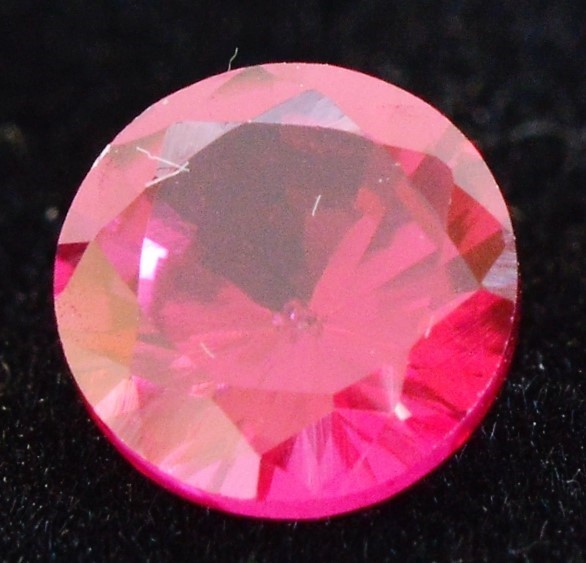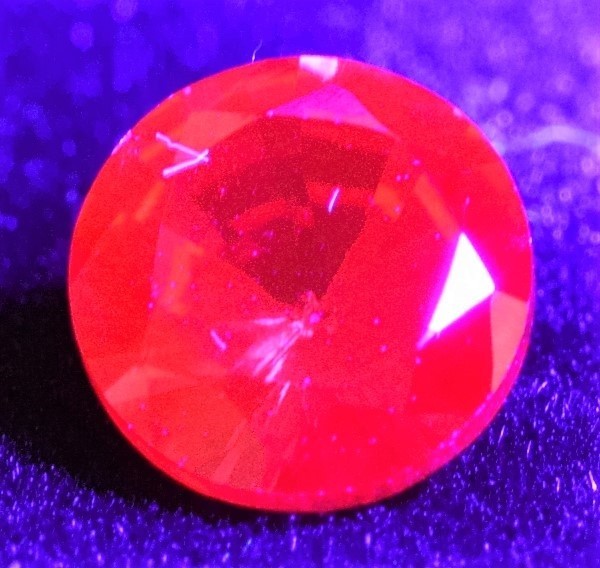© Kirk Feral 2009-present, All Rights Reserved. These materials may be duplicated for educational purposes only. No part of this website may be duplicated or distributed for profit, for commercial purposes, or for posting to another website without the expressed written consent of the copyright holder.
Colorless Spodumene
LWUV Fluorescence: Strong due to Manganese
Magnetic Response: Inert
Blue Apatite
LWUV Fluorecence: Moderate due to Rare Earth Metals
Magnetic Response: Weak due to Rare Earth Metals
Divalent iron (Fe2+) can quench fluorescence when concentrations are above trace amounts (more than 0.1%). Natural Ruby provides a good example of fluorescence-quenching. Synthetic Ruby contains little or no iron and always fluoresces strong red due to a high concentration of chromium, which can also cause weak magnetic attraction. The intensity of fluorescence in synthetic Ruby can be orders of magnitude greater than in natural Ruby. Chromium is also the primary chromophore and activator in natural Ruby. Fluorescence is strong in low-iron high-chromium natural Rubies, but many Rubies show only weak or moderate fluorescence, and some natural Rubies can be inert to long wave UV light.
Fluorescence is weaker in natural Ruby not only because natural Rubies often contain less chromium than synthetic Rubies, but also because they contain a significant amount of iron. It follows that synthetic Rubies are on average less magnetic than natural Rubies. We have found that increasing concentrations of iron in natural Rubies is associated with greater magnetism and lower fluorescence.
Synthetic Ruby
LWUV Fluoresence: Strong due to Chromium
Magnetic Response: Weak due to Chromium
Natural Ruby
LWUV Fluorescence: Inert
Magnetic Response: Moderate due to Iron & Chromium
Chrome Pyrope Garnet gems are dark red and can contain several times more chromium (4%-8% chromium oxide by weight) than the reddest Rubies, but Chrome Pyrope gems do not fluoresce. This is primarily because Chrome Pyrope has much higher iron content than Ruby. The amount of fluorescence-quenching iron (Fe2+) in these Garnets typically causes a Drag response to a magnetic wand. The lack of fluorescence in Chrome Pyrope is also likely due to a phenomenon known as concentration quenching, which in this case involves an over-abundance of chromium. A high saturation of an activator that normally causes fluorescence can in some cases reduce or eliminate the fluorescence (Robbins, Manuel, 1994). Concentration quenching can occur when the concentration of chromium oxide is greater than 1% by weight.
Fluorescence in Relation to Magnetism
Strong gem fluorescence transforms the appearance of a gem, and this phenomenon can be dazzling and beautiful to behold. Fluorescence that is visible to the naked eye is quite common among colored stones, and gem identification of colored stones using fluorescence is one of the most enjoyable methods in gemology. But unfortunately this method is also quite under-utilized.
Cobalt in trace amounts creates blue body color in daylight and pink or red fluorescence under UV light in synthetic blue Spinel gems, which are magnetically inert. Cobalt (blue color), along with iron (gray color), also create grayish blue body color in natural blue Spinels that are not Cobalt Spinels. Most natural blue Spinels contain too much iron for the cobalt component to fluoresce, but cobalt can create pink/red fluorescence in rare natural Cobalt Spinels that are low in iron. All natural blue Spinel gems other than Cobalt Spinels are weakly to strongly magnetic due to iron. The rare Cobalt Spinel from Viet Nam pictured below derives its pure blue body color and strong pink fluorescence from cobalt. This gem shows weak magnetic attraction when floated, likely due to a small amount of iron.
Uvarovite Garnet
LWUV Fluorescence: Inert
Magnetic Response: Large Crystals Drag
Chrome Pyrope Garnet
LWUV Fluorescence: Inert
Magnetic Response: Drags
Yellowish Scapolite
LWUV Fluorescence: Strong due to Iron (Fe3+)
Magnetic Response: Inert
The activator manganese (Mn2+) along with a co-activator such as lead can cause orangey pink fluorescence in colorless Spodumene and in pink Spodumene, also known as Kunzite. Both gems are diamagnetic. Manganese (Mn2+) by itself can create yellow fluorescence in some gems, particularly under short wave UV light. Even iron can be an activator of fluorescence (as per the Online Database of Fluorescent Minerals). Iron (Fe3+) in trace amounts induces pink fluorescence in yellow Scapolite, which is a magnetically inert gem that derives its yellow body color from color centers.
Pink Zircon
LWUV Fluorescence: Strong due to Rare Earths
Magnetic Response: Inert (Diamagnetic)
Colorless Sapphire
LWUV Fluorescence: Strong due to Chromium Magnetic Response: Inert
One of the most common activators that causes LWUV fluorescence in gems is chromium, which induces pink to red fluorescence under long wave UV light. As a coloring agent in gemstones, chromium can produce either red or green body color under visible light. Unlike chromium, vanadium does not cause red fluorescence, and gems colored green primarily by vanadium rather than chromium can sometimes be distinguished by a lack of red fluorescence. Higher concentrations of vanadium V3+ relative to chromium Cr3+ will actually quench fluorescence from chromium at least as effectively as iron quenches fluorescence.
Chromium is highly fluorescent, and slight gem fluorescence can at times occur even in daylight, as seen in some high-chromium low-iron Rubies. The relatively high concentrations of chromium found in some Ruby and Emerald gems can also induce weak magnetic attraction.
But the concentrations of chromium and other activators such as manganese in gemstones are usually lower than what can be detected with a magnet, and often the concentrations are so low that the activators/chromophores produce no gem body color at all in visible light. For instance, chromium ions can cause bright pink fluorescence under LWUV light in a number of allochromatic gemstones without producing any red or green body color in daylight. An example is colorless Sapphire, which fluoresces pink under UV light due to chromium. The Sapphire below is diamagnetic (inert).
Colombian Emerald
Fluorescence: Strong due to Chromium
Magnetic Response: Inert
Various rare earth metals are responsible for fluorescence in a number of gem varieties, as in the blue Apatite pictured below left, which fluoresces pink. Blue Apatite is inert to weakly magnetic due to rare earth elements such as neodymium/praseodymium, which may contribute to fluorescence along with other rare earth elements. The heated brownish pink Zircon shown below right is also colored by rare earth metals. This Zircon fluoresces bright yellow under long wave UV light, likely due to dysprosium, although the rare earths involved are not known for certain.
Cobalt Spinel
LWUV Fluorescence: Strong due to Cobalt
Magnetic Response: Weak due to Cobalt & Iron
Chrome Tourmaline
Fluorescence: Strong due to Chromium
Magnetic Response: Inert
At times, more than one activator may be responsible for fluorescence within a single gem, as we find in some synthetic Spinels (see Spinel pg.3). As another example, the weakly magnetic colorless “Leuco” Grossular Garnet pictured below fluoresces orangey pink due to a combination of chromium and manganese. Chromium acts as an activator and not a chromophore in this natural gemstone, causing pink fluorescence under long wave UV light. The manganese activator is also not a chromophore and reveals itself as orange fluorescence when the gem is viewed with a blue laser. Manganese fluorescence changes to yellowish green under short wave UV light.
In this colorless Garnet, chromium, vanadium and manganese are present in concentrations too low to contribute to the weak magnetic attraction. The very low magnetic susceptibility we detect with a magnetic wand is due entirely to a small amount of cryptic iron (Fe3+), which is neither an activator nor a chromophore in this gem.
Fluorescence in this colorless Grossular Garnet can be analyzed with a spectrometer when we use a UV light source rather than the traditional incandescent light source. This is called fluorescence spectroscopy, and it can help us identify which metal activators are present. With this type of spectroscopy, we examine the light that is transmitted by activators rather than the light that is absorbed by chromophores. On the transmission spectrum graph below for the colorless Grossular Garnet, we clearly see the long wave UV transmission peaks of manganese in the yellow/orange portion of the light spectrum, as well as peaks indicating chromium transmission in the red portion of the spectrum. One researcher (Gaft, M., 2013) has suggested that the red fluorescence in Grossulars may be due to divalent vanadium V2+ rather than chromium, but V2+ has not been firmly established. to be an activator in gemstones.
Colorless Grossular Garnet
Fluorescence Transmission Spectrum for Colorless Grossular Garnet
405nm Excitation
Our studies reveal that fluorescence is almost always restricted to allochromatic gemstones, which are less magnetic than idiochromatic gems. The primary cause of the fluorescence in colored stones is metal ion impurities, most commonly chromium and manganese. Fluorescence often involves the same paramagnetic transition metals and rare earth metals that can cause magnetic attraction, absorption spectra, Chelsea filter reactions and gem color. When these metals cause fluorescence, they are referred to as "activators".
Fluorescence in gems can be caused by extremely small concentrations of elements, even as low as a few parts per billion. Metallic activators are often found in trace amounts (less than 0.1% by weight) within gems, and although they may be detected via fluorescence, concentrations are usually too low to induce any visible magnetic attraction, even when the sensitive flotation method is used. As examples, the light green Colombian Emerald pictured above and the dark green Chrome Tourmaline pictured below both show green body color in daylight due to chromium and vanadium, and red fluorescence under UV light due to chromium. Because both gemstones have a low concentration of chromium (likely less than 0.4%) and contain no magnetically detectable iron (under 0.1%), they are magnetically inert (diamagnetic). Iron (Fe2+) quenches fluorescence in gems, and low levels of iron permit fluorescence to occur.
An excellent example of concentration quenching is found in Uvarovite Garnet, which is an idiochromatic gem colored dark green by high chromium content. Whether in druse form or as large individual crystals, Uvarovite does not fluoresce. This Garnet species is quite magnetic, but not due to iron or manganese. Large individual Uvarovite crystals show a Drag response to a magnetic wand due almost entirely to an exceptionally high concentration of chromium (up to 27% chromium oxide by weight). This level of chromium inhibits all fluorescence.
On occasion, uranium acts as an activator in gems, causing green fluorescence, as it does in some rare Opals such as Hyalite Opal. Uranium is also involved in green phosphorescence in Australian Opals, a phenomenon that separates Australian Opals from Ethiopian Opals. Uranium is quite magnetic, but due to very low concentrations of this activator, Opals that show fluorescence or phosphorescence due to uranium are magnetically inert.
Hyalite Opal, Zacatecas, Mexico
LWUV Fluorescence: Strong Green due to Uranium
Magnetic Response: Inert
We compiled a Fluorescence Index for Gemstones based on our own fluorescence testing. The alphabetical index lists all gems that we have tested that fluoresce under longwave and/or shortwave UV light, and the causes of fluorescence (activators) are also presented to the best of our knowledge. Access the Index here:
Fluorescence Index for Gemstones
Synthetic Garnets that fluoresce are not listed on the index, but they are shown on this page: Synthetic Garnets.
For a list of references regarding fluorescence in gems and minerals, see the Fluorescence References section at the bottom of the Resources and Links page.
To examine fluorescence in gems, we use a long wave ultraviolet (LWUV) flashlight (365nm-375nm wavelength), a blue laser (405nm), and a short wave ultraviolet (SWUV) tube lamp (254nm). We also use fluorescence spectroscopy to help us determine the causes of fluorescence in individual gems. Nearly all photos of fluorescence shown below were taken under long wave UV light.
Magnetism in Gemstones
An Effective Tool and Method for Gem Identification
© Kirk Feral
Among minerals, fluorescence is widely known and popular among mineral collectors, and fluorescence in Diamonds is studied extensively by researchers. Oddly, among transparent colored stones, fluorescent gems and cabs receive relatively little attention in gemology, and their luminous charm is rarely featured or displayed under UV light.
Many gems show fluorescence, a type of luminescence where light is emitted as a glow of color when ultraviolet (UV) light is applied. Blue-violet laser light and green laser light can also on occasion cause fluorescence/luminescence. The types of metal ions involved in gem fluorescence are often the same types of metals involved in magnetic susceptibility.
Synthetic Blue Spinel under UV Light
Red Fluorescence: Strong due to cobalt
Magnetic Response: Inert






























